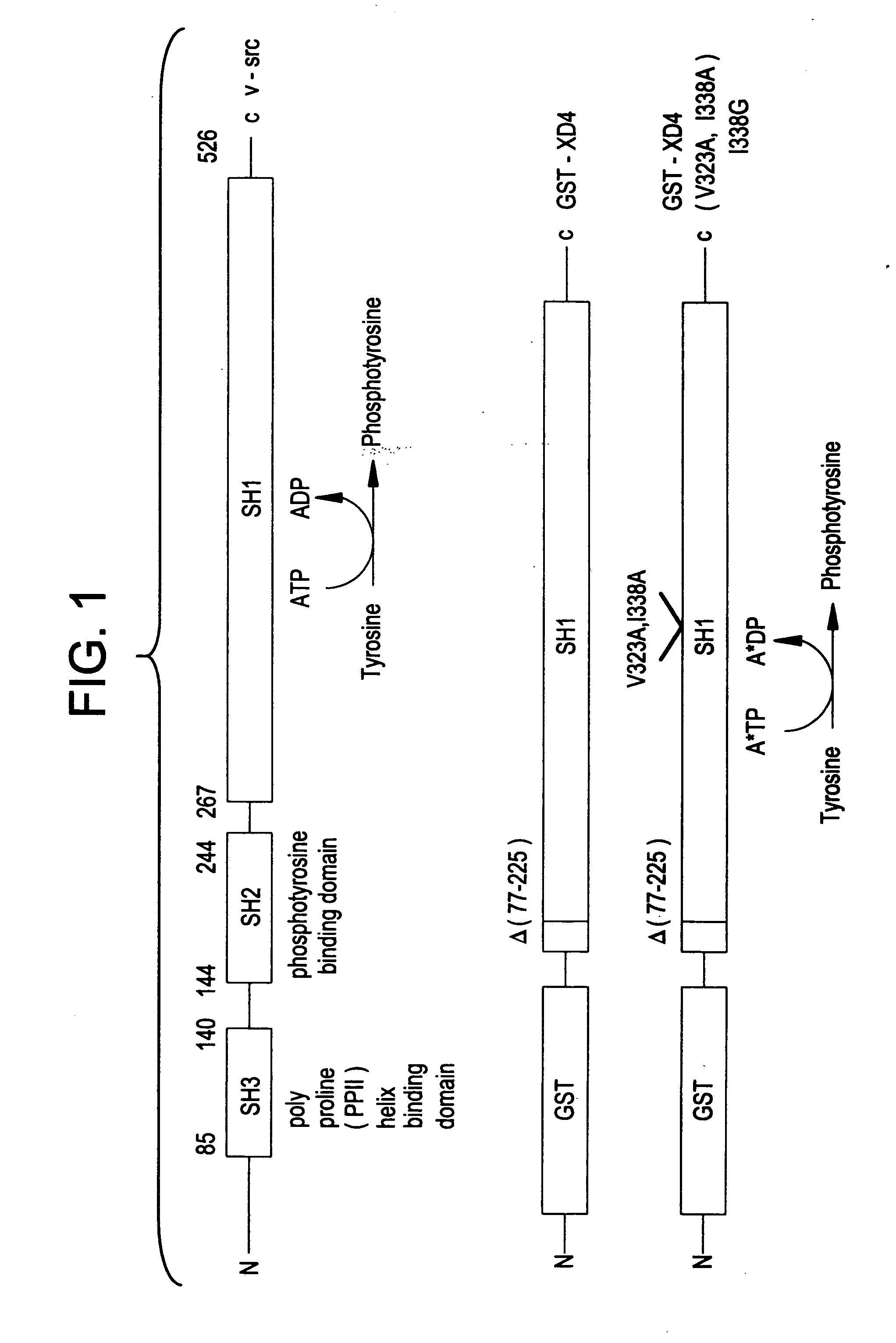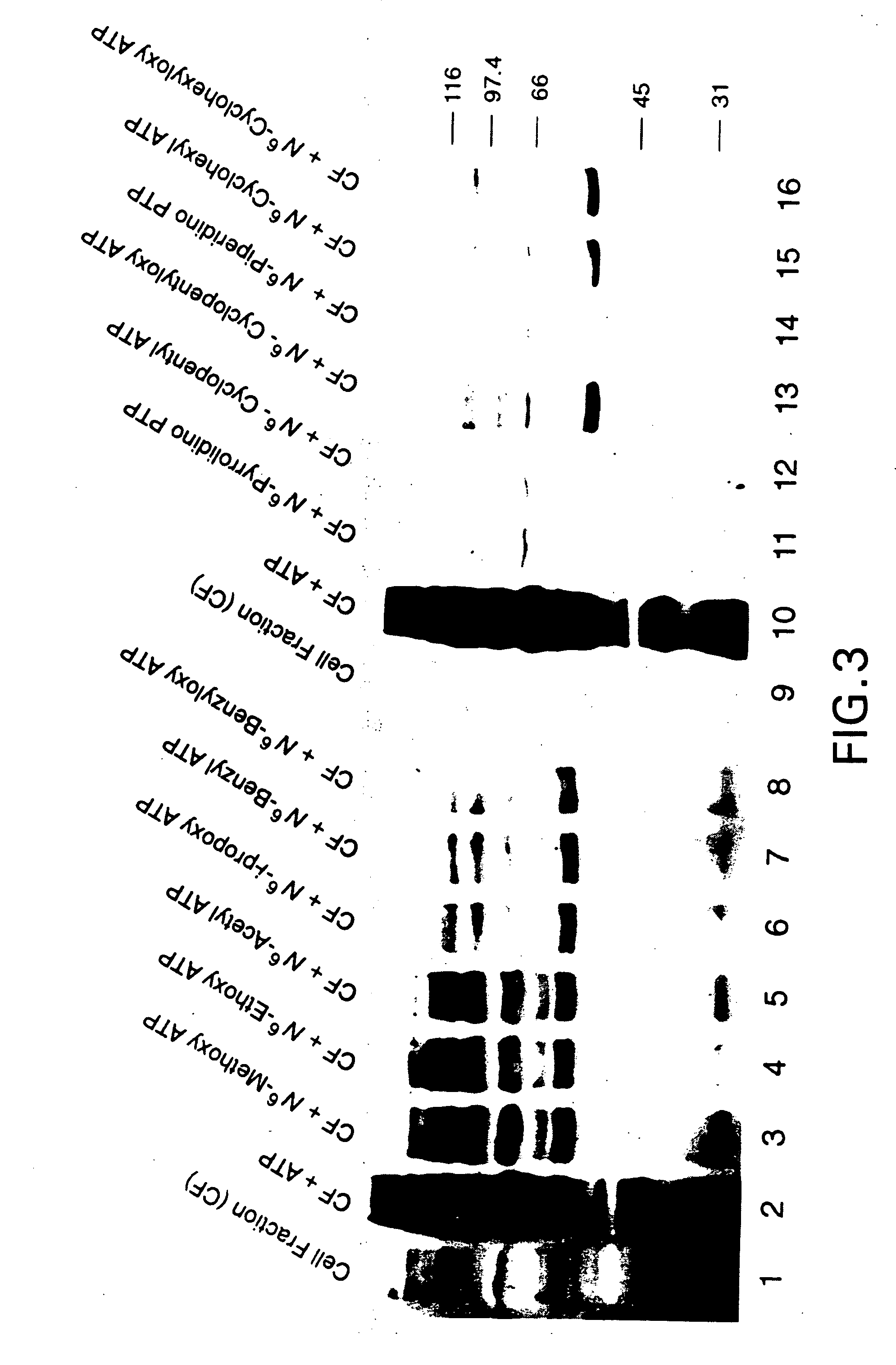Engineered protein kinases which can utilize modified nucleotide triphosphate substrates
a technology of nucleotide triphosphate and protein kinase, which is applied in the field of biotechnology, can solve the problems of increasing or decreasing the activity of certain metabolic pathways, complex, and insufficient binding of ligands to provide for complex responses, and achieve the effect of reducing or eliminating the cause or symptoms of diseas
- Summary
- Abstract
- Description
- Claims
- Application Information
AI Technical Summary
Benefits of technology
Problems solved by technology
Method used
Image
Examples
example 1
Synthesis of ATP Analogs
[0147] Twelve different orthogonal ATP analogs were synthesized. FIG. 2 is a schematic representation of their structure. The figure shows adenosine triphosphate (ATP), with an “X” bound to the 6 position; and in the box below, schematic representations are provided for the twelve side chains that take the place of “X” in each of the orthogonal ATP analogs described in the examples (which are always referred to by the numbers 1-12 set forth in bold typeface). Those analogs are:
1N6(methoxy)ATP2N6(ethoxy)ATP3N6(acetyl)ATP4N6(i-propoxy)ATP5N6-(benzyl)ATP6N6-(benzyloxy)ATP7N6-(pyrolidino)ATP8N6-(cyclopentyl)ATP9N6-(cyclopentyloxy)ATP10N6-(pipperidino)ATP11N6-(cyclohexyl)ATP12N6-(cyclohexyloxy)ATP
[0148] Analogs 1, 2, 4, 6, 9, and 12 were synthesized via Dimroth rearrangement of the corresponding N1 alkoxy adenine derivatives in four steps starting from adenosine, according to the procedure of Fujii et al.(43). Analog 5 was synthesized similarly via Dimroth rea...
example 2
Screening of Nucleotide Analogs
[0152] To identify compounds that would not be accepted as substrates by any existing cellular kinases (53), we screened a panel of synthetic A*TP analogs in a murine lymphocyte lysate (CF) rich in protein tyrosine kinases(13).
[0153] The assays were performed using spleenocytes (8-30 week old male and female C57 / B6 mice from the Princeton University Animal Facility) which were isolated and washed in RPMI-1640 medium containing 5% Bovine Calf Serum (BCS), 1% Hepes and DNAsel (1 μg / ml). Red cells were lysed at 4° C. by treatment with 17 mM tris ammonium chloride pH 7.2. The cells were hypotonically lysed on ice for 10 min. in 1 mM Hepes pH 7.4, 5 mM MgCl2, leupeptin (10 μg / ml), aprotinin (10 μg / ml) and 100 μM PMSF according to the method of Fukazawa et al. (51). After vortexing and centrifugation at 500×g, the supernatant was collected. Cells were stored at 4° C. for 20 min. to attenuate the basal protein phosphorylation level, after which the buffer ...
example 3
Designing the Mutant v-Src
[0158] No crystal structures of any tyrosine kinases in an active conformation have been solved to date although several structures of inactive kinases have been solved (54,55). However, two crystal structures of catalytically active ser / thr kinases have been solved (56,57). There is a high degree of functional homology between the ser / thr and the tyrosine kinase catalytic domains as shown by affinity labeling of the identical catalytically active lysine residue in both kinase families (K72 in cAMP dependent kinase (PKA), K295 in v-Src) (58,58). Inspection of the PKA (56) and cyclin dependent kinase-2 (CDK2)-cyclinA (57) crystal strictures revealed two amino acid side chains within a 4 Å sphere of the N6 amino group of bound ATP: V104 / M120 (PKA) and V64 / F80 (CDK2) (60).
[0159]FIG. 4 shows a close-up view of the ATP binding site in cAMP dependent protein kinase (PKA), which is bound to ATP. Three residues within a 4 Å sphere of the N6 amine of ATP (Val104,...
PUM
| Property | Measurement | Unit |
|---|---|---|
| volume | aaaaa | aaaaa |
| reaction volume | aaaaa | aaaaa |
| reaction volume | aaaaa | aaaaa |
Abstract
Description
Claims
Application Information
 Login to View More
Login to View More - R&D
- Intellectual Property
- Life Sciences
- Materials
- Tech Scout
- Unparalleled Data Quality
- Higher Quality Content
- 60% Fewer Hallucinations
Browse by: Latest US Patents, China's latest patents, Technical Efficacy Thesaurus, Application Domain, Technology Topic, Popular Technical Reports.
© 2025 PatSnap. All rights reserved.Legal|Privacy policy|Modern Slavery Act Transparency Statement|Sitemap|About US| Contact US: help@patsnap.com



